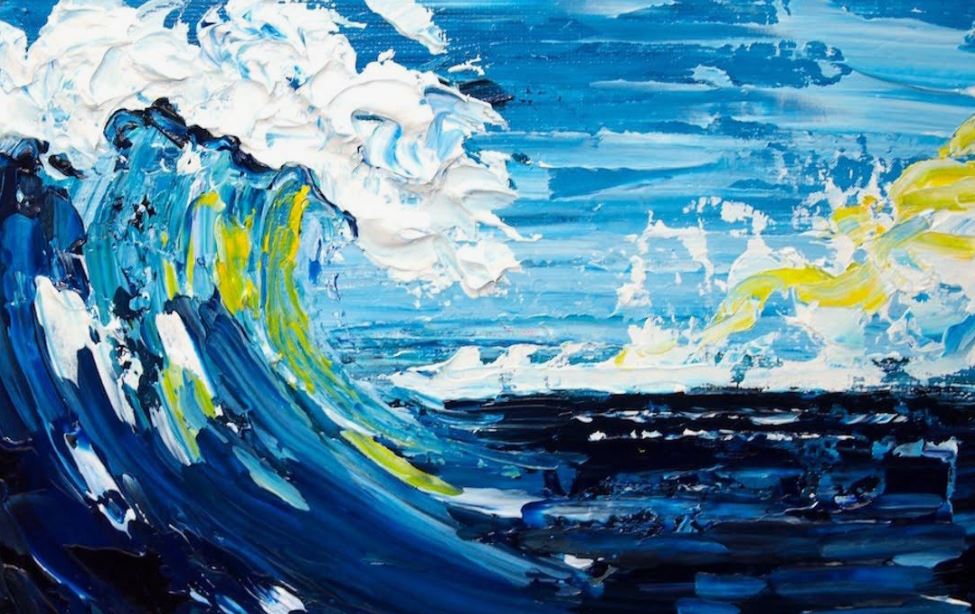In the vast galaxy of the art world, acrylic paint sparkles like a bright star, radiating an exceptional mix of versatility and accessibility. From art students to professional painters, acrylic paint has become essential to the artist’s toolbox. Moreover, its unparalleled adaptability across myriad art forms makes it a favorite among creatives globally.
This guide will delve into the fascinating world of acrylic paint, from the basics for beginners to advanced techniques for seasoned artists. So, whether you’re new to the world of painting surfboards or looking to refine your skills, this blog post is for you.
Understanding Acrylic Paint
Acrylic paint is a fast-drying paint consisting of pigment suspended in an acrylic polymer emulsion. Acrylic paints can be diluted with water but become water-resistant when dry. Depending on the technique, they can resemble oil or watercolor paints, offering the best of both worlds.
Pros and Cons of Acrylic Paint
Advantages:
-
Versatility: Acrylics can be applied to many surfaces like canvas, wood, paper, glass, or textiles.
-
Fast-Drying: Unlike oils, acrylics dry quickly, allowing you to work faster.
-
Easy to Clean: Acrylic paint is water-soluble, and brushes can be cleaned with soap and water.
Disadvantages:
-
Fast Drying Time: While this can be an advantage, it can also lead to a painting drying before it’s finished.
-
Changing Colors: Acrylics darken slightly when dry, affecting color matching.
Distinct Features of Acrylic Paint
-
Flexibility: Once dry, acrylic paint, unlike oil-based paints, doesn’t crack or turn yellow over time.
-
Opacity: Acrylic paints can be thinned to a transparent state or used straight from the tube for a more opaque effect.
-
Permanence: Once acrylic paint dries, it’s permanent and water-resistant, so you can paint layers without disturbing the underlying color.
Essential Supplies for Acrylic Painting
Different Types of Acrylic Paints and Their Uses
-
Heavy Body Acrylics: Thick and great for creating texture with a brush or palette knife.
-
Fluid Acrylics: Thinner consistency suitable for detail work, staining, and watercolor-like washes.
-
Acrylic Inks: Superfluid, ideal for airbrushing, pen and ink style techniques, or when a smooth, even coverage is desired.
-
Interactive Acrylics: These unique paints delay drying, allowing you to work with wet paint longer.
Brushes and Palette Knives
-
Brushes: For detail work, go for small, fine brushes. For large color applications and bold strokes, choose larger brushes.
-
Palette Knives: Ideal for mixing paint and creating textured applications.
Surfaces for Acrylic Painting
-
Canvases: Traditional choice, can be bought pre-stretched and primed.
-
Acrylic Paper: Specially designed for acrylic paint.
-
Wood Panels: Provide a rigid surface for painting.
Step-by-Step Guide
Simple Landscape Painting
-
Step 1: Start by sketching a simple landscape composition using a light pencil.
-
Step 2: Block in your main areas of color with a broad brush.
-
Step 3: Gradually refine these areas, adding minor details as your layers dry.
Still Life Painting
-
Step 1: Arrange a few objects on a table and sketch their outlines.
-
Step 2: Start painting the objects, beginning with the largest areas of color.
-
Step 3: Refine the painting by adding smaller details and shadows.
Abstract Acrylic Painting
-
Step 1: Choose a color scheme.
-
Step 2: Apply colors freely, not worrying about creating a recognizable image.
-
Step 3: Experiment with different brushstrokes, tools, and techniques to create interesting textures and shapes.
Portrait Painting
-
Step 1: Begin with a sketch of your subject, focusing on getting the proportions right.
-
Step 2: Block in the main areas of color, starting with the larger shapes.
-
Step 3: Gradually add more detail, paying attention to the variations in skin tone and the details in the eyes and hair.
Intermediate to Advanced Techniques and Tips
Advanced Color Theory
Understanding the color wheel and the relationships between colors can significantly improve your painting. This includes understanding complementary colors, split-complementary colors, analogous colors, and triadic color schemes.
Limited Palette Mastery
Working with a limited palette forces you to learn more about mixing colors and can lead to a more harmonious painting. It often involves using primary colors, white, and possibly brown or black.
Understanding Light and Shadow
Mastering the use of light and shadow can bring your artwork to life. This involves understanding the direction of light, the color of light, and how it affects the colors and values in your painting.
Different Styles and Genres
This could involve exploring different art movements (like Impressionism, Expressionism, or Pop Art), trying out various subject matters, or even mixing other mediums with your acrylics.
Finding Your Voice
Developing your artistic voice involves experimenting, reflecting on your work, and understanding what themes, subjects, or styles resonate with you. It’s a personal journey that evolves.
Caring for Acrylic Paintings
Properly Drying and Curing Acrylic Paintings
Allow your painting to dry completely before varnishing or framing it. While acrylics are touch-dry within minutes, they can take a few weeks to cure (harden) fully.
Framing and Displaying
Choose a frame that complements your painting but doesn’t overpower it. When hanging your artwork, avoid areas with direct sunlight or extreme temperatures.
Cleaning and Preservation
Dust your painting regularly with a soft brush. If deeper cleaning is necessary, a slightly damp cloth can be used. Never use cleaning products or solvents.
Environmental Protection
Protect your artwork from UV rays and dust by applying varnish. This will also enhance the colors and provide a choice of finishes: matte, satin, or gloss.
Conclusion
As we’ve journeyed through acrylic painting, we’ve covered the basics, explored techniques for beginners and advanced artists alike, and provided a step-by-step guide to creating your first custom painted surfboards. We’ve also addressed troubleshooting common mistakes and offered advice on how to care for your masterpieces.
But this is only the beginning. The beauty of acrylic painting is its versatility and the endless opportunities for creativity and expression. So whether you’re a novice artist just dipping your brush into the paint or a seasoned professional, there’s always something new to discover in acrylic painting.




